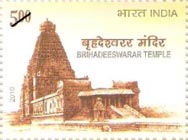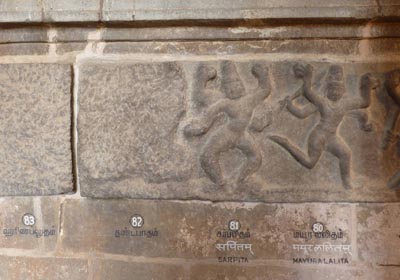 Commemorating a millennium at a seminar
|
The vimana of the Brihadishvara temple casts a shadow between 3 and 4 pm every day, contrary to popular belief that it never casts a shodow. The temple is constructed using a single type of stone, granulite, and is not built with granite, another common myth. Many such myths associated with the Big Temple were revealed by Dr. Chitra Mahadevan, an archaeologist and scholar, in her lecture at a symposium held recently at the C.P. Ramaswami Aiyar Foundation to commemorate the Brihadishvara temple’s 1000th year.

The last of the Karana-s (dance poses) and the panels awaiting sculpting in the Big Temple. (Photograph: S. Anwar.)
|
The symposium had artists, archaeologists and scholars presenting little known facts about this world heritage monument. “Another common belief is that the temple has been carved out of a single stone, but it is the statue of the Nandi that is carved using a single piece of rock,” said Dr. Chitra.
The temple has some of the oldest Karana sculptures in India, depicting in minute detail hand gestures. The distance of the hand from the body is represented through a sculpture of Shiva holding a veena. These sculptures were the focus of Dr. Padma Subrahmanyam’s lecture-demonstration on the Bharata Natya Karanas. The well-known dancer pointed out, “Commonly perceived as another dance movement, it is less known that the veena is used to show the right distance of the hand from the body. Such minute details have been creatively and animatedly portrayed.” Another interesting facet seen is every sculpture having four hands. “Two hands depicted the pose and the other two represented the end of the entire movement,” she explained.
The discovery of 81 of the 108 Karanas in the vimana occurred in 1956 when Balakrishnan, from the Archaeological Survey of India (ASI), was getting rid of the dense vegetation surrounding the vimana. He discovered a passage leading to the first tier of the vimana and K.R. Srinivasan, Superintending Archaeologist of the ASI (Madras Circle), opened up the passage that led to a chamber. Covered in layers of bat excreta, it was only after weeks of cleaning that the dancing figurines of Shiva were finally revealed. “The temple was in complete ruins, surrounded by dense vegetation and weeds. It was an arduous task restoring the heritage structure,” recalled Dr. Padma.
Dr. Subbarayalu, Head of the Department of Indology at the French Institute, Pondicherry, spoke of several less known facts about the inscriptions found in the temple. The majority of the inscriptions detail enumeration and gifts given by the King and his family to the temple. Surprisingly, apart from King Rajaraja Chola I, the inscriptions mention details of gifts only from his queens and his sister. No other male members of the royal family are mentioned. Nor are any local bodies, like Sabhas, Uru or Natas, mentioned. Two lesser known inscriptions refer to the gifts in the form of land that the King donated to the temple. These lands were obtained as income from the neighbouring forty villages within the Cauvery Delta.
Inscriptions depicting the kinds of jewellery and precious stones donated by the King are to be found but their source is never mentioned. These inscriptions illustrate the sources of the gold obtained and, in most contexts, the King mentions fighting fierce battles with the Pandya and Kerala rulers and bringing gold from these lands after his victories. It can be clearly said that the technology of ornament-making had highly developed in Rajaraja Chola’s day.
In an inscription of his reign found at Tirumalavadi near Tiruchi, his orders state that the central shrine of the Vaidyanatha temple should be rebuilt and that before pulling down the walls the inscriptions engraved on them should be copied in a book. The records were successfully re-engraved on the walls from the book after the rebuilding was finished. Rajaraja Chola I introduced innovations in his inscriptions and was the first to record military achievements. Officers of his army regiments and soldiers in groups who made endowments to the temple are mentioned, and not other officials in his empire.
Pradeep Chakravarthy’s presentation on the temple’s earliest photographs brought to light facts on photography in Chennai in the early days. The Madras College of Arts was the first institute to teach photography in the city and Captain Linnaeus Tripe of the British army was the first official teacher. He photographed the entire lot of temple’s inscriptions individually, but of the seven copies produced, only one remains – in Canada. Tripe was the first to stress preservation and documenting of the inscriptions. A striking feature of his photography is that none of his pictures includes people.
The heritage hall where the programme was conducted was recently renovated and this was the first function held after the installation of new airconditioners. Rejecting demolition plans, the hall was carefully restored.
|